River Garnock: Difference between revisions
| Line 17: | Line 17: | ||
Otters and water voles live on the estuary as well as numerous breeding birds, including water rail, grasshopper warbler and sand martin. The Garnock/Irvine estuary is also a Wildlife Site.<ref>{{cite web |url=http://www.south-ayrshire.gov.uk/community/LBAP/publications/coastal.pdf |title=Ayrshire Biodiversity Action Plan, Coastal and Marine Habitats |publisher=South Ayrshire Council |archiveurl=http://web.archive.org/web/20050111202854/http://www.south-ayrshire.gov.uk/community/LBAP/publications/coastal.pdf |archivedate=11 January 2011}}</ref> | Otters and water voles live on the estuary as well as numerous breeding birds, including water rail, grasshopper warbler and sand martin. The Garnock/Irvine estuary is also a Wildlife Site.<ref>{{cite web |url=http://www.south-ayrshire.gov.uk/community/LBAP/publications/coastal.pdf |title=Ayrshire Biodiversity Action Plan, Coastal and Marine Habitats |publisher=South Ayrshire Council |archiveurl=http://web.archive.org/web/20050111202854/http://www.south-ayrshire.gov.uk/community/LBAP/publications/coastal.pdf |archivedate=11 January 2011}}</ref> | ||
Bogside Flats SSSI covers | Bogside Flats SSSI covers 627 acres that include inter-tidal mudflats, salt-marsh and adjacent pasture land.<ref>{{cite web |url=http://www.snh.org.uk/pdfs/publications/commissioned_reports/F02L122.pdf |title=Commissioned Report No. 038 |publisher=Scottish Natural Heritage |date=October 2002}}</ref> | ||
==Pictures== | ==Pictures== | ||
Latest revision as of 12:44, 7 September 2015

The River Garnock, the smallest of Ayrshire's six principal rivers, has its source on the southerly side of the Hill of Stake in the heart of the Clyde Muirshiel Regional Park. About a mile and a half south of this starting point the young stream tumbles over the Spout of Garnock, the highest waterfall in Ayrshire, once thought to be the river's origin.
Below the Spout the Garnock continues, for a total length of 20 miles or so, through the towns of Kilbirnie, Glengarnock, Dalry and Kilwinning to its confluence with the River Irvine at Irvine Harbour.
The main tributaries of the Garnock are the Rye Water and Caaf Water which join north and south of Dalry respectively and the Lugton Water which joins just south of Kilwinning.
Garnock Valley
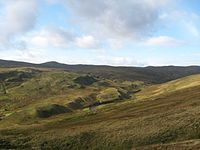
"Glen Garnock" pertains specifically to the short, sometimes precipitous, section of ravine overlooked by the ruins of Glengarnock Castle north of Kilbirnie, whereas "The Garnock Valley" is used of a wider geographic area of northern Ayrshire abutting Renfrewshire, which encompassees the parishes of Beith, Dalry, and Kilbirnie.
Estuary
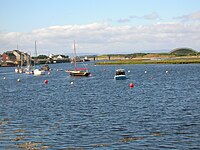
Within Ayrshire by far the largest estuary has developed, behind the Ardeer Peninsula, at the confluence of the Irvine and Garnock Rivers. This is one of the best examples of a bar-built estuary in the United Kingdom and is the only major estuary between the Solway and Inner Clyde. The majority of the estuary has been designated a SSSI, in recognition of its national importance for three bird species; eider, red-breasted merganser and goldeneye. It is also a nationally important feeding ground for thousands of migrating birds during the spring and autumn.
Otters and water voles live on the estuary as well as numerous breeding birds, including water rail, grasshopper warbler and sand martin. The Garnock/Irvine estuary is also a Wildlife Site.[1]
Bogside Flats SSSI covers 627 acres that include inter-tidal mudflats, salt-marsh and adjacent pasture land.[2]
Pictures
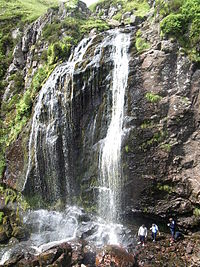 |
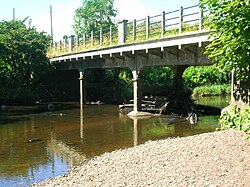 |
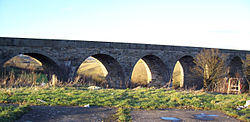 |
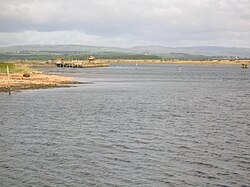 |
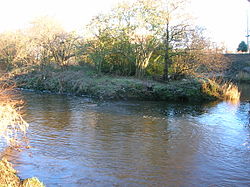 |
Sights of interest along the river
- Clyde Muirshiel Regional Park, the source of the Garnock
- Spout of Garnock, the highest waterfall in Ayrshire
- Glengarnock Castle, a ruined keep on a remote rocky promontory overlooking the river, 2 miles north of Kilbirnie
- Nether Mill, a ruined watermill that leaves as its legacy the name of the local football team, Kilbirnie Ladeside, who originally played in a field beside the mill lade running from a weir on the river to the mill at the end of Knoxville Road.
- Dalgarven Mill, the river still turning its restored undershot waterwheel. The mill complex is now a tourist attraction and home to the Museum of Ayrshire Country Life and Costume.
- Kilwinning Viaduct, on the former Lanarkshire and Ayrshire Railway, is now used by the Sustrans Garnock Valley Cycleway[3] to cross the river.
- Eglinton Country Park, developed around the ancient Eglinton Estate, home for 600 years to the Earls of Eglinton and Winton
- Garnock Floods, a wildlife reserve of the Scottish Wildlife Trust in Kilwinning[4]
- Ardeer Factory, once the world's largest commercial explosives factory, on a natural peninsula with the Firth of Clyde on its west side, the River Garnock to the east, and the mouth of the River Irvine to the south[5]
In the River Garnock some distance below Kilwinning Bridge in the Dirrans area, in the vicinity of the old saw mill and close to where the lade to the mill started,[6] was Saint Ninian's Isle, named after the saint who is otherwise mainly commemorated at Whithorn.[7] It is now part of the river banking.
'Mess(rs?) Johns Steps' are shown on the first edition of the 6 inch OS map, near the confluence with the Lugton Water; stepping stones across the river.
Smith records in 1895 that an island called Ringen's Isle existed in the Garnock. This may have been named after Saint Ringen or Winning.[8]
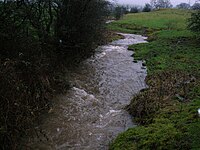
Salmon generally arrive in the Garnock at the end of July, with the most productive part of the river being the stretch between Kilbirnie and Dalry.[9]
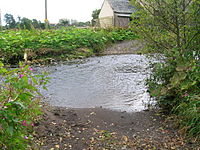
Tributaries
Tributaries of the river include:
- Pundeavon Burn (55.75639 -4.68556, from Pundeavon Reservoir, entering the Garnock just upstream of Kilbirnie Cross.
- Paduff Burn (55.75361 -4.68556), known locally as Jock's Burn.
- Powgree Burn (55.73639 -4.67944)
- Pitcon Burn (55.71917 -4.70389), which carves the tree lined gully known as Swinlees Glen[10] a Nature Conservation Site, and enters the Garnock near Pitcon House
- Rye Water (55.71167 -4.70778), running through the old village of Drakemyre to join the Garnock north of Dalry. A ford across the river at Drakemyre is associated with the song "Comin' Thro' the Rye".[11]
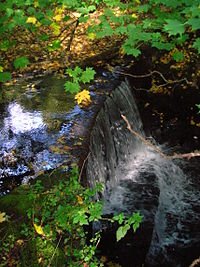
- Putyan Burn: joining near the Lovers' Bridge in Dalry. At Broadlie House is a small weir once part of an abandoned 1892 hydroelectric scheme.
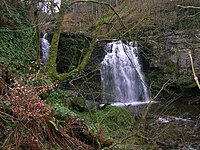
- Caaf Water (55.69778 -4.71389), enters the Lynn Glen with its picturesque waterfall and the Garnock south of Dalry.
- Bombo Burn (55.69111 -4.70944), a small stream 5 miles long from Bankhead Moss and through the Blair Estate
The delightfully landscaped grounds and gardens of the Estate contain a wonderful mixture of species trees and shrubs from all over the world. The Bombo Burn meanders gently for a mile through the gardens creating many natural beauty spots.[12]
- Dusk Water: (55.68028 -4.71222), rising on Cuff Hill, near Beith, running through Barrmill and joining the Garnock above Dalgarven.

Interesting places along its course, as well as several old watermills, are Giffin House, a large and handsome mansion-house, and Cleeves Cove, a system of caves in the Dusk Glen.
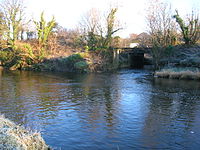
- Lugton Water (55.64306 -4.68556), the largest tributary of the Garnock, running 14 miles from Loch Libo in Uplawmoor, through Lugton, Neilston, Beith, Dunlop, Stewarton and Kilwinning to join the Garnock below the tidal limit below Eglinton Country Park.

The Garnock and the Irvine
The two main rivers of the Cunninghame area of Ayrshire are the Irvine and the Garnock, which come together in the estuary at Irvine Harbour and jointly enter the Firth of Clyde.
As these rivers flow into the estaury, the Garnock is swollen by the Annick Water that has its confluence at the Dirrans in Kilwinning. The silt from these rivers has created the Bogside mudflats and the course of these rivers has been greatly altered over the centuries through natural, man made and even spiritual influences.
A mining disaster
On 20 June 1833 the surface of the Garnock was seen to be ruffled and it was discovered that a section of the river bed had collapsed into mineworkings beneath. The river was now flowing into miles of mineworkings of the Snodgrass, Bartonholm and Longford collieries. Attempts were made to block the breach with clay, whin, straw, etc. to no avail. The miners had been safely brought to the surface and were able to witness the sight of the river standing dry for nearly a mile downstream, with fish jumping about in all directions. The tide brought in sufficient water to complete the flooding of the workings and the river level returned to normal. The weight of the floodwater was so great that the compressed air broke through the ground in many places and many acres of ground were observed to bubble up like a pan of boiling water. In some places rents and cavities appeared measuring four or five feet in diameter, and from these came a roaring sound described as being like steam escaping from a safety valve. For about five hours great volumes of water and sand were thrown up into the air like fountains and the mining villages of Bartonholm, Snodgrass, Longford and Nethermains were flooded.
Archibald William, the enterprising 13th Earl of Eglinton purchased all the lands concerned in 1852 and through the simple expedient of cutting a short canal at Bogend, across the loop of the river involved, he bypassed the breach and once the river course had been drained and sealed off he was able to have the flooded mineworkings pumped out. The breach lay on the sea side of the loop close to Bogend on the Snodgrass Holm side.[13] The Earl leased the mines to Bairds of Gartsherrie and the "Eglinton Iron Works" were born.[14]
The curse of Saint Winning
A legend tells of Saint Winning sending his monks to fish in the Garnock, however no matter how hard they tried or how long they persevered they could catch nothing. The saint in response placed a curse on the river, preventing it from ever having fish in its waters; the river responded by changing course and thereby avoiding the curse.
It is clear that the river has substantially changed its course in recorded history, previously having entered the sea at Stevenston; Ardeer therefore being an island at that time. Blaeu's map printed in 1654 shows this.[15]
It was also noted during the construction of a canal serving early coal pits at Ardeer that the small lochans used to ease construction lay on the old course of the River Garnock.
The Earls of Eglinton
It is recorded in official documents of the 1770 "Trial of Mungo Campbell for the Murder of Alexander, Earl of Eglinton" that Alexander Montgomery, 10th Earl of Eglinton was very protective of his fishing rights on the River Garmock to the extent that he banned fishing on the river altogether. Mungo Campbell even sold his fishing rod; however the murder of the earl in 1769 was as a direct result of Mungo's being accused of poaching at Ardrossan's North Bay and Lord Eglinton's attempt to confiscate his gun.
Outside links
| ("Wikimedia Commons" has material about River Garnock) |
- Ayrshire Rivers Trust
- YouTube Video of the River Garnock near Glengarnock Castle
- YouTube Video of Dalgarven Mill and the River Garnock
- The Pundeavon Reservoir
References
- ↑ "Ayrshire Biodiversity Action Plan, Coastal and Marine Habitats". South Ayrshire Council. Archived from the original on 11 January 2011. http://web.archive.org/web/20050111202854/http://www.south-ayrshire.gov.uk/community/LBAP/publications/coastal.pdf.
- ↑ "Commissioned Report No. 038". Scottish Natural Heritage. October 2002. http://www.snh.org.uk/pdfs/publications/commissioned_reports/F02L122.pdf.
- ↑ Garnock Valley Cycleway
- ↑ "Garnock Floods". Scottish Wildlife Trust. Retrieved 13 May 2013.
- ↑ Dolan, John E. (18 May 1998). "Alfred Nobel in Scotland". Nobelprize.org.
- ↑ Ness, J. A. (1969-70). Landmarks of Kilwynnyng. p. 61.
- ↑ "Saint Ninian Placenames". The Whithorn Trust. Retrieved 13 May 2013.
- ↑ Smith, John (1895). Prehistoric Man in Ayrshire. London: Elliot Stock. p. 61.
- ↑ "River Irvine". Trout and Salmon Fishing in Scotland. Retrieved 13 May 2013.
- ↑ "Dalry, Swinlees Glen; Report of excursion to". Glasgow Naturalist V: 72. 1913.
- ↑ John Cairney (1 January 2011). The Luath Burns Companion. Luath Press Ltd. p. 267. ISBN 978-1-906817-85-5. http://books.google.com/books?id=uDl8PS0QH1IC&pg=PA267.
- ↑ Blair House: Grounds and Gardens
- ↑ Brotchie, Alan W. "Some Early Ayrshire Railways". Sou'West Journal 38. p. 13.
- ↑ MacDonald, A. M. (1968). "Some notes on a Kilwinning mining disaster". Inquirer 1 (3).
- ↑ "Blaeu Atlas of Scotland, 1654". National Library of Scotland. Retrieved 13 May 2013.
